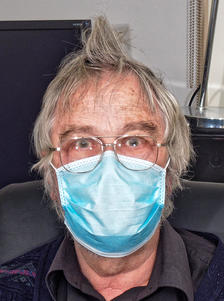
|
| Greg's diary |
|
||||||||
|
|
|
||||||||||||||||
| Tuesday, 1 July 2025 | Today's diary | Today's images | top | next | last |
As promised, Brett Younger showed up today to install the new dishwasher, just as we were about to prepare breakfast. Why didn't he tell me when he was coming, as arranged? Oh, he did: he sent me an SMS ¾ hour before.
Should only take about 10 minutes, right? Wrong. It took him nearly an hour. Admittedly he put it in more tidily than I would have done, but I was still surprised.


|
|
|||||||||
And when it was done, the thing wouldn't work. After some concerns about DOA, it seems that this particular model takes a long time to wake up the first time it is used. After that, all seems to be normal.
First time use was easy enough, though I still need to work out how to load the thing. To my surprise, the “Auto” setting took over 3 hours, much longer than the other machines. And in passing I discovered that not only does the machine have a setting 0 for water hardness, it was set that way when I got it. Other machines have always insisted that the water has some residual hardness, which is not the case with rain water.
And how does “Extra Dry” work? Not worse than the other machines, but also not completely dry. The Bosch is better than the Whirlpool, and this seems better than the Bosch, but in each case glasses and bowls in the top shelf retain water and need to be dried with a tea towel, so there seems to be little advantage in more drying.
Security is important of course, especially on the Internet where so few people really understand what's going on. But current methods are just plain ridiculous. I hate CAPTCHAs with a vengeance, and I suspect that my refusal to fill one out confused The Good Guys' computer system, and maybe that's why I haven't received a single email from them during the entire fiasco.
But is it necessary? Yesterday I went in to the Ballarat shop and had to pick up an invoice that they could more easily have sent to me by email. And the only identification they wanted was a phone number. Anybody could have picked it up.
Somewhere in between is the question of multi-factor authentication, typically a message sent to your mobile phone. That can work, though it's irritating. But what if you have initiated the transaction from the same phone? I've seen a couple of cases like that, and under those circumstances it has no use whatsoever. I wonder what security will be like in 10 years' time.
Another pain is SMS. It should no longer exist. It grew up in the early days of digital phones, where phones and Internet had nothing to do with each other, and to enter text you had to use the numeric (only) keypad with multiple presses per letter. Now every phone has Internet standard email, but not only do people not use it, there seems to be an insurmountable barrier between the two.
Of course, neither SMS nor email are appropriate when you want to contact somebody quickly and be sure that they get the message. There phone calls are more appropriate, as would have been this morning when Brett contacted me. But for some reason (maybe difficulty in using the app) voice calls seem to be decreasing. I just can't understand how anybody can go through the pain of a glass keyboard for a quick message.
In passing, The Good Guys' sent their cancellation message by SMS, and it took me a day to find it. If I hadn't found it today, things would have been very different: instead of $733, they are asking $999, fully $266 or 36% more than I paid. That would certainly have been worth a breach of contract complaint.
How do you restore old photos? Both Affinity and ACDSee offer functionality to do it. But there are no tutorials to back it up, and my attempts have been less than successful.
Ask Google Gemini? Yes, what you need is PhotoGlory.
Oh. I had never heard of it. Out to take a look, and yes, it seems to offer just what I want. Download the trial version, which at least allowed me to rotate images and change their exposure. But to use the features for which it's intended, I have to buy the product!
OK, it's only (US) $39.20 for a lifetime license for the PRO version. I can do that. But I ended up paying $7.45 more: they had decided that I was in Germany (why? Do they have outdated geolocation software?) and charged me 19% EU GST. Sent their support line a message, but got no response.
Trying it out was almost intuitive, and with little effort I was able to restore some old photos. Here a couple taken in late 1957:

|
|
|||||||||

|
|
|||||||||

|
|
|||||||||

|
|
|||||||||
On the whole, things look a whole lot better, but there are plenty of artefacts that appear to have been inserted where it couldn't work out what to do, like on my left foot here:

|
|
|||||||||

|
|
|||||||||
And the aspect ratio seems to change. Maybe there's a way round that. After all, I spent very little effort to get these results. It also offers other things, like colouring old photos, and that could be interesting.
| Wednesday, 2 July 2025 | Today's diary | top | previous | next | last |
We have a dishwasher! No day 8.
Well, I still need to learn how to use it, in particular how to stack glasses without wasting lots of space, something that no dishwasher does well. But that's for another day. Today I caught up with much of the stuff that I have let lie.
Today I spent far too much time preparing for my planned outing to the Western Treatment Plant, one of the best places in the southern hemisphere to see wild birds. It's arranged by OM System, I suspect to help sell their telephoto lenses, but how do I prepare? Should I accept the fact and wear boots, the first time in decades?
It proved to be more difficult than I thought. It took me nearly 10 minutes to put on two socks and one boot. It brings home how old and stiff I have become. I will be able to do it tomorrow if I must, but I should first check if I need to. And why has it taken me so long to prepare? I'm taking 4 cameras, 6 lenses, 5 spare batteries and a monopod. What else?
| Thursday, 3 July 2025 | Today's diary | Today's images | top | previous | next | last |
Up in the middle of the night (well, 6:00) this morning to participate in OM System's bird photography meeting at the Western Treatment Plant near Lara. On the way, things didn't look promising, lots of rain and drizzle. But round 7:30 things cleared up and I saw one of the prettiest sunrises in a long time. It took me a while to decide to stop and take a photo, by which time it had diminished significantly:
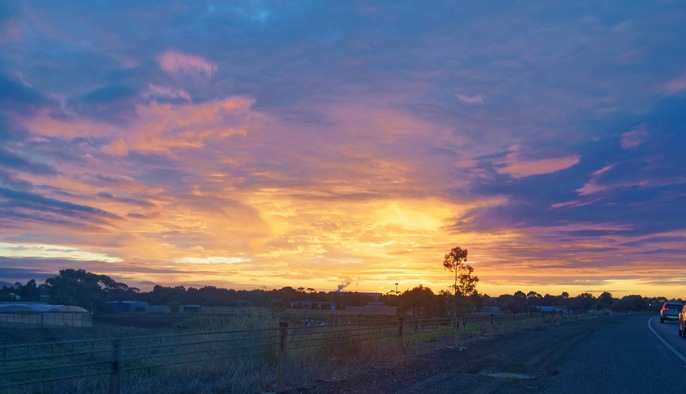
|
|
||||||||||
But I wasn't expecting the sun to rise exactly on the freeway in front of me:
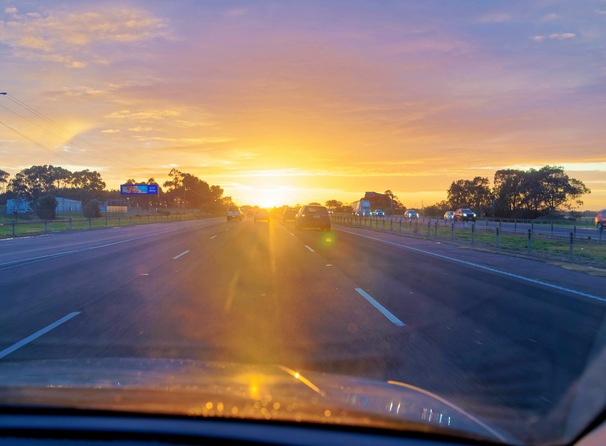
|
|
||||||||||
Got there at 7:55, wondering if anybody else would be there. But they all were, all ten of them including Aaron Harivel, the OM System representative who arranged the event. Discovered a number of things:
While talking to Aaron, showed him my OM System OM-1 Mark II with the white spot in the “live view” viewfinder. He tried—again—to remap pixels, and of course it failed again. So, he says, send it in for servicing. I'm not looking forward to discussing the matter with CCCWarehouse, but having his view will (hopefully) make things easier.
I'm still sorting out the nearly 400 photos that I took today. First impressions: surprisingly few useless shots (only about 5%), but clearly nearly all that will need cropping, something that will keep me busy. Here a couple that won't:

|
|
||||||||||

|
|
||||||||||

|
|
||||||||||

|
|
||||||||||
The last was taken with the 150-400/4.5 shown here, along with the inbuilt 1.25× teleconverter:

|
|
||||||||||
That's at 500 mm, the equivalent of a 1000 mm “full frame” lens, hand held. But somehow I don't see the real advantage over my Leica DG Vario-Elmar 100-400 mm f/4.0-6.3, and Aaron agreed that you'd really need a good reason for it.
I'll need to do something with photos like this, but I'm not sure what yet:

|
|
||||||||||
And then there's this bird, the only one of its kind.

|
|
||||||||||
That's surprising considering that I was less than 8 km from the end of runway 36 of Avalon Airport, and the plane must have been a couple of kilometres closer. But clearly it wasn't a commercial plane. I guessed a Cessna 172 or maybe 152 (the model in which I trained decades ago). And how about that, the resolution was good enough that I could read the registration, VH-NHL

|
|
||||||||||
And Flight Radar 24 tells me that yes, it's a Cessna 172, it belongs to RMIT, and it lives at Avalon Airport. So maybe it had really just taken off from runway 36. It's just surprising that we didn't see any other planes. And the image quality is surprisingly good for a hand-held 6000 mm “full frame” equivalent focal length.
After the birding meeting, off to Geelong to look for Chinese and Malaysian foodstuffs that I couldn't find in Ballarat. First to a place that I had marked with the hope of getting a good lunch, but it seems that I marked the wrong place on the map, and ended up at Fresh Land Food, 153 - 161 Shannon Ave in Manifold Heights:

|
|
||||||||||
That was interesting. They have an amazing amount of stuff in a very small area, including more Japanese and Korean food than I have seen elsewhere, such as these Udon and Ramen noodles:

|
|
||||||||||

|
|
||||||||||
Interestingly, the Japanese text on both sides reads “Chinese noodles” (run the cursor over an image to compare it with its neighbour):

|
||||||||||||||||||||||||

|
||||||||||||||||||||||||
They also had a number of “instant noodle” dishes with the difference that they were made in Malaysia, despite the Vietnamese and Thai claims:

|
|
||||||||||

|
|
||||||||||
They will be interesting to try, if only to get a feeling for what Malaysian people consider edible.
On then to the Gourmet Asian Grocery in Belmont for my usual Tean's Gourmet spice pastes and Chung Hing dòufu, drawing a blank for the latter: it seems that nobody likes them any more, or maybe they have gone broke. A pity either way.
I had 380 photos to process today. DxO PhotoLab is slow at the best of times, but today it took several minutes to even display the initial screen. Looking at local network traffic, I saw a lot of
15:46:03.538507 IP eureka.lemis.com.microsoft-ds > distress.lemis.com.52560: Flags [.], seq 366736144:366737604, ack 63457, win 12575, length 1460SMB-over-TCP packet:(raw data or continuation?)
15:46:03.538625 IP distress.lemis.com.52560 > eureka.lemis.com.microsoft-ds: Flags [.], ack 366346324, win 65534, length 0
15:46:03.538631 IP bad-len 0
15:46:03.538748 IP distress.lemis.com.52560 > eureka.lemis.com.microsoft-ds: Flags [.], ack 366355084, win 65534, length 0
15:46:03.538753 IP bad-len 0
What does that mean? ACK length 0? That makes no sense, and tcpdump said so. But somehow things moved on: the ACK value incremented in steps of 8760 bytes (why?), and eventually things worked out. But why? Is this a bug in Microsoft, DxO, Samba or tcpdump? In any case, it's no longer as obvious that DxO alone is to blame for the glacial performance.
And since I had taken many photos at 30°/800 ISO, I ran the whole thing with “DeepPrime”, taking a total of 7 hours, 34 seconds.
Pizza for dinner tonight. That requires something like 20 minutes pre-heating the oven to reach the 250° that it can barely achieve. But today, after 30 minutes, it was still heating FHU (“fast heat up”), and it was having difficulty getting any further.
Has an element burnt out? It wouldn't be the first time. But how do I find out without having somebody come out here, dismantle it and say “It's broke. It'll cost $500, but it's not worth it. Today's bill comes to $100”.
So yet another investigation of new kitchen appliances. Yes, it's 10 years old and yes, I hate it, but will I like a newer one any better?
| Friday, 4 July 2025 | Today's diary | top | previous | next | last |
I hadn't planned to do much photo stuff today, since there's clearly a lot to do to process yesterday's photos. But one was easy, the Skyhawk:

|
|
||||||||||
That's in dire need of cropping. How hard can it be? With various excursions, it took me several hours. The simple thing is just to crop it:

|
|
||||||||||
But that's messy, with lots of artefacts. How about cropping it in DxO PhotoLab and then put it through “Perfectly Clear“?

|
|
||||||||||
That's much better, but too dark. In fact, the output of DxO looks the best:

|
|
||||||||||
And as I said yesterday, that's really quite impressive for a hand-held image corresponding to 6120 mm “full frame” focal length.
But why should that take much time? The Exif data. I still couldn't get ExifTool to play nice with the OM System OM-1 Mark II. OK, time to post a question on the ExifTool forum. Prepare an example:
Oh. I've been trying to write to the JPEG output of DxO PhotoLab. That's not ideal for blaming ExifTool. Try again with the raw image.
Oh. The problem doesn't occur with the raw image! What happens if I try to copy the Exif from raw to the JPEG image?
That works, but it causes more non-reproducible problems. But it seems that I can update the Exif data on the raw file and then copy it. I still don't understand what's going on, and why it sometimes works and sometimes doesn't, but I can live with it unless it comes back to bite me again. A couple of scripts to change, and I have worked around the issue.
So, a new oven? Off to take a look. I wasn't expecting it to be easy, and I wasn't disappointed. Appliances Online didn't want to know about 90 cm ovens! Well, maybe it does, but it gave me no way to select them.
Back to The Good Guys. They have 90 cm ovens ranging in price from $1399 to $4190, still considerably cheaper than the $11,500 that Appliances Online want for a 60 cm oven.
What do I get for that money? Hard to say. Somehow the comparison shows things that are uninteresting to me, and I can't find out what I want to know. How much power do they use? For the (maximum) four that I “compared”, they only showed 2. The Omega OBO9011AM, the cheapest they offer, also uses the most power, an advantage for an oven. And how hot do they get? Again only two ovens divulge that information. 240° for the Haier HWO90S10EX2, 250° for the Omega. And I was hoping for a higher temperature.
Somehow this is all too much pain. Back to our current oven to try to guess which (if any) element is burnt out. It doesn't seem to be the rear (fan) element, nor the bottom element. I need to let it cool down between each attempt, and I didn't get any further. But potentially I had just forgotten how long it takes for the oven to heat to 250°. More investigation needed.
Our new LG XD5B14PS dishwasher comes with advertising for LG ThinQ.
What's that? Buzzwords galore, a way to increase the pain of your smart phone by communicating with the dishwasher? About the only thing I could establish is that you can select custom wash cycles, though it's not clear what. Downloaded the app from the toyshop and started it. Please log in! Create an account! Dammit, LG, will I need an account to use your appliances next? And why do you subject me to the pain of entering text on a mobile phone?
Ah, you can sign up with a Real Computer too. Maybe. And it wants to know my date of birth! Dammit, what are you playing at? Of course there's no way for it to know, which is good, because I can't even enter it (though there's a field for entering it in the wrong format, today being 7/4/2025). I have to select from a toy calendar.
For some reason (masochism?) I tried it. It hung. Tried again. It hung. Tried again with a different browser. It hung. Tried to send mail to support. What kind of device do you have? What's wrong with it? No option to complain about their appalling web site. Selected some random stuff and sent off the real report in the text attachment (at least they allow that). No reply.
LG, what are you playing at? Are you Yet Another company who just wants to annoy their customers?
| Saturday, 5 July 2025 | Today's diary | Today's images | top | previous | next | last |
One of the nice things about the OM System OM-1 Mark II is that I can charge the battery from USB. After downloading files from the camera, I simply turn it off and leave it to charge. As a result, I have never used the two spare batteries that I bought along with the camera.
But today I came into my office to find the “battery empty” indicator flashing. It was still connected to the USB cable. Disconnect. No change. Turn on and off. No change. Finally I got it to stop by removing and replacing the battery, after which it showed 100% charge.
What happened? It seemed that hydra didn't want to let go. Looking at the system log, I had:
Jul 4 17:05:19 hydra kernel: (da3:umass-sim1:1:0:1): fatal error, failed to attach to device
Jul 4 17:05:19 hydra kernel: da3 at umass-sim1 bus 1 scbus9 target 0 lun 1
Jul 4 17:05:19 hydra kernel: da3: <OMSYSTEM OM-1MarkII 1.00> s/n BJRA15001 detached
Jul 4 17:05:19 hydra kernel: (da3:umass-sim1:1:0:1): Periph destroyed
Jul 5 08:02:54 hydra kernel: ugen0.3: <OMSYSTEM OM-1MarkII> at usbus0 (disconnected)
Jul 5 08:02:54 hydra kernel: umass1: at uhub2, port 12, addr 90 (disconnected)
Jul 5 08:02:54 hydra kernel: umass1: detached
So yesterday evening, when I was finished, the system noted the event and removed the “disk” device /dev/da3. But it didn't see a disconnect until this morning. Why? I'll have to keep my eye on it.
Today I spent an inordinate amount of time trying to document my success in copying Exif data to images from my OM System OM-1 Mark II, with little success. Every time I think I have got a workaround, I find they don't work or are not repeatable. Today I tried geotagging:
=== grog@hydra (/dev/pts/18) ~/Photos/20250703 872 -> exifx orig/A7032091_DxO.jpg
File orig/A7032091_DxO.jpg
Date taken: Thursday, 3 July 2025, 11:23:58
Exposure: 1/1600 sec, f/6.3 (EV 16.0), 800/30 ISO
Camera: OM Digital Solutions OM-1
Lens: LEICA DG 100-400mm f/4.0-6.3
Focal length: 400.0 mm
Meter mode: Multi-segment Aperture-priority AE
Comp: +1.3 EV
Size: 5184 x 3888 pixels (20.16 megapixels)=== grog@hydra (/dev/pts/18) ~/Photos/20250703 873 -> geotag orig/A7032091_DxO.jpg
GPSLOG /src/GPS/Tracklogs/Phones/GPSLogger/albo/20250703.gpx
exiftool -geotag=/src/GPS/Tracklogs/Phones/GPSLogger/albo/20250703.gpx orig/A7032091_DxO.jpg
1 image files updated
All well and good. But then I copied the Exif data from the raw file to correct the time (the camera was running 80 s too fast):
=== grog@hydra (/dev/pts/18) ~/Photos/20250703 875 -> exiftool -overwrite_original_in_place -TagsFromFile orig/A7032091.ORF '-all>all' orig/A7032091_DxO.jpg
Warning: [minor] Writing large value for MakerNotes - orig/A7032091_DxO.jpg
1 image files updated=== grog@hydra (/dev/pts/18) ~/Photos/20250703 876 -> geotag orig/A7032091_DxO.jpg
GPSLOG /src/GPS/Tracklogs/Phones/GPSLogger/albo/20250703.gpx
exiftool -geotag=/src/GPS/Tracklogs/Phones/GPSLogger/albo/20250703.gpx orig/A7032091_DxO.jpg
Warning: [minor] File contains multi-segment EXIF - orig/A7032091_DxO.jpg
Warning: [minor] File contains multi-segment EXIF - orig/A7032091_DxO.jpg
Error: Can't write multi-segment EXIF with external pointers - orig/A7032091_DxO.jpg
0 image files updated
1 files weren't updated due to errors
Why? It already had that data. But ExifTool is trying to update the existing Exif data in A7032091_DxO.jpg. What happens if I remove it all and just copy it? First, how do I remove the Exif data? Google Gemini to my aid again:
To remove all EXIF data:exiftool -all= your_photo.jpg
OK, I can do that:
=== grog@hydra (/dev/pts/18) ~/Photos/20250703 861 -> exiftool -all= orig/A7032091_DxO.jpg
Warning: [minor] File contains multi-segment EXIF - orig/A7032091_DxO.jpg
1 image files updated=== grog@hydra (/dev/pts/18) ~/Photos/20250703 862 -> exifx orig/A7032091_DxO.jpg
File orig/A7032091_DxO.jpg
Size: 5184 x 3888 pixels (20.16 megapixels)=== grog@hydra (/dev/pts/18) ~/Photos/20250703 863 -> exiftool -overwrite_original_in_place -TagsFromFile orig/A7032091.ORF '-all>all' orig/A7032091_DxO.jpg
Warning: [minor] Writing large value for MakerNotes - orig/A7032091_DxO.jpg
1 image files updated=== grog@hydra (/dev/pts/18) ~/Photos/20250703 864 -> exifx orig/A7032091_DxO.jpg
File orig/A7032091_DxO.jpg
Date taken: Thursday, 3 July 2025, 11:22:36
Location: 38.00496 S, 144.58989 E
Exposure: 1/1600 sec, f/6.3 (EV 16.0), 800/30 ISO
Camera: OM System OM-1 Mark II, serial BJRA15001
Lens: Leica DG Vario-Elmar 100-400 mm f/4.0-6.3
Focal length: 400.0 mm (full frame equivalent: 800 mm)
Focus: MF; C-AF, MF, Imager AF 127.39 m (118.50 - 137.72 m)
Field of view: 2.5 horizontal, 1.9 vertical, 3.1 diagonal
Meter mode: ESP Aperture-priority AE
Stabilization: On, Mode 1
Comp: +1.3 EV
Size: 5184 x 3888 pixels (20.16 megapixels)=== grog@hydra (/dev/pts/18) ~/Photos/20250703 865 -> exiftool -overwrite_original_in_place -TagsFromFile orig/A7032091.ORF '-all>all' orig/A7032091_DxO.jpg
Warning: [minor] File contains multi-segment EXIF - orig/A7032091_DxO.jpg
1 image files updated
But it's not repeatable. I think there's a secondary effect in play, maybe related to the location of the data in the image file. It would be really nice to find a solution. Does it have something to do with DxO PhotoLab, maybe? After all, it seems possible to update the raw image.
As if all that wasn't enough, while processing my house photos I got this message on stopping Hugin:
Crash Annotation GraphicsCriticalError: |[0][GFX1-]: Detect DeviceReset DeviceResetReason::NVIDIA_VIDEO DeviceResetDetectPlace::WR_POST_UPDATE in Parent process (t=314.609) |[1][GFX1-]: Detect DeviceReset DeviceResetReason::NVIDIA_VIDEO DeviceResetDetectPlace::WR_POST_UPDATE in Parent process (t=512.092) |[2][GFX1-]: Detect DeviceReset DeviceResetReason::NVIDIA_VIDEO DeviceResetDetectPlace::WR_POST_UPDATE in Parent process (t=1200) |[3][GFX1-]: Detect DeviceReset DeviceResetReason::NVIDIA_VIDEO DeviceResetDetectPlace::WR_POST_UPDATE in Parent process (t=1561.49) |[4][GFX1-]: Detect DeviceReset DeviceResetReason::NVIDIA_VIDEO DeviceResetDetectPlace::WR_POST_UPDATE in Parent process (t=2263.19) |[5][GFX1-]: Detect DeviceReset DeviceResetReason::NVIDIA_VIDEO DeviceResetDetectPlace::WR_POST_UPDATE in Parent process (t=81123.4) |[6][GFX1-]: Detect DeviceReset DeviceResetReason::NVIDIA_VIDEO DeviceResetDetectPlace::WR_POST_UPDATE in Parent process (t=81163.4) [GFX1-]: Detect DeviceReset DeviceResetReason::NVIDIA_VIDEO DeviceResetDetectPlace::WR_POST_UPDATE in Parent process
What a mess! Is that an indication of problems with the display hardware, or just a Heisenbug?
| Sunday, 6 July 2025 | Today's diary | Today's images | top | previous | next | last |
Linda and Graeme Swift along this morning for breakfast. They have bought a new “smart” TV, with which they are well pleased. It's interesting to hear the opinions of normal users. They agree that the thing is far too complicated, and that it would be nice to single step images. But what choice do they have?
They also tell me that they have free access to Prime Video. That sounded unlikely, and later I tried it out on hires, my “smart” TV. No access. Do they maybe have an Amazon Prime account? But looking at what was on offer, I didn't find anything to interest me further.
One of the rugs in our lounge room is looking the worse for wear:

|
|
|||||||||
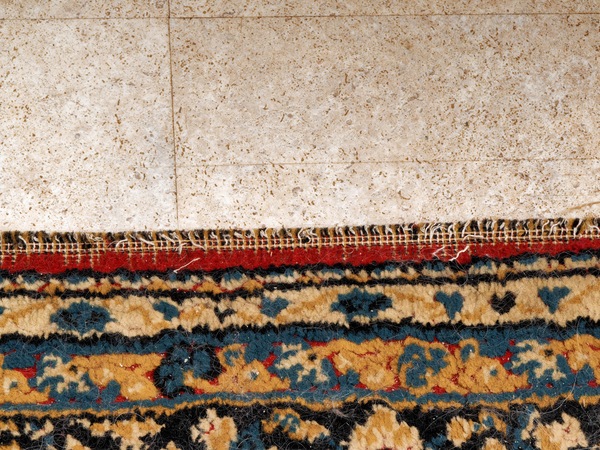
|
|
|||||||||

|
|
|||||||||
Yvonne has been looking for a replacement for some time. They're not cheap. She tells me they sell for upwards of $800. But she has seen a number of second-hand rugs round the $100 mark.
We have the money. Why should we buy a second-hand rug? The obvious reason is because it's cheaper, and if it does the job, why pay more? Today she found one in Canadian, 2×2.9 m in size, for $120. Off to take a look. Yes, it didn't look bad, and we got it for $100. Back home with it, arousing the interest of the dogs:
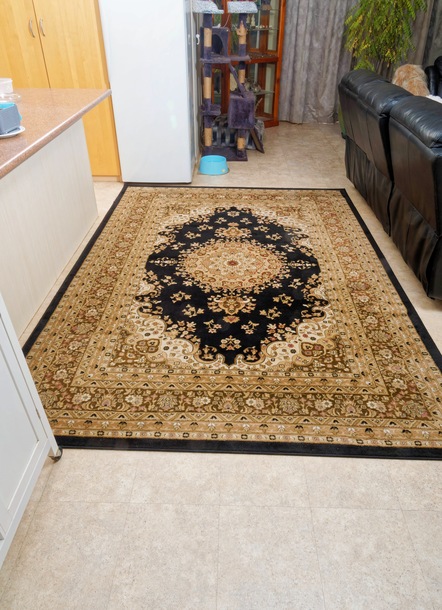
|
|
|||||||||
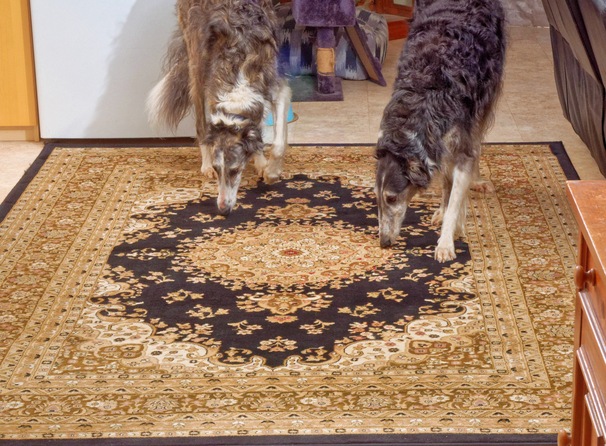
|
|
|||||||||
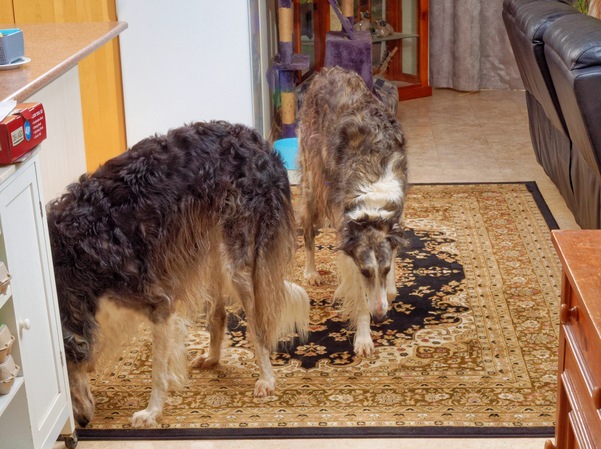
|
|
|||||||||
And what is it? A Turkish Kashgar, not a name greatly associated with rugs. The ones I have seen look very different.
It wasn't until later that I realized how well Bruno blends in:
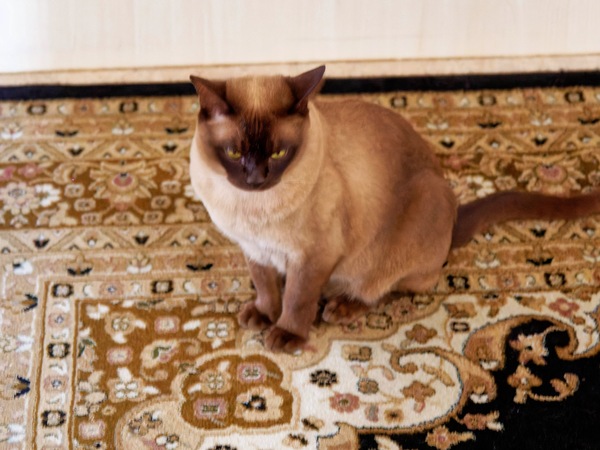
|
|
|||||||||
That's not all good. At one point I trod on him because he had blended in so well.
| Monday, 7 July 2025 | Today's diary | Today's images | top | previous | next | last |
Once again I'm behind on daily things. My mail queue, an indication of my overload, is up to over 80 messages. Spent some time today trying to tidy things up, and managed to get my mail queue down to 13. Some of those are particularly important ones that I have let drag for months.
Yvonne's machine, lagoon.lemis.com, is seriously down-rev:
=== grog@lagoon (/dev/pts/9) ~ 2 -> uname -a
FreeBSD lagoon.lemis.com 12.1-STABLE FreeBSD 12.1-STABLE r355358 GENERIC amd64=== grog@lagoon (/dev/pts/9) ~ 3 -> l /boot/kernel/kernel
-r-xr-xr-x 1 root wheel 31,364,536 12 Dec 2020 /boot/kernel/kernel
I had started to upgrade it over two years ago, but somehow didn't finish. But now I have a new machine, the one I bought for running Microsoft Windows 11 a few months back, but which proved to be only marginally faster than distress. So I ordered a new SSD, found I had the wrong kind, returned it and finally got a functional one.
What a pain these Lenovo motherboards are! I've already been through all that when I got it, but I had to go through it all over again today.
Finally it was in place, and I was able to establish that the “BIOS” setup doesn't report it, at least not in any form that I can see. But FreeBSD finds it and was able to install on it. It also enabled me to check the speed of the “disk”. It's no speed demon: dd reported read speeds round 700 MB/s. To be checked again when the system is up and running.
Now to configure the beast. But where are my notes? They're not in my HOWTO page. Did a bit of obvious configuration to bring it into my network, but it looks like I'm in for another search for the notes that I know I made.
Seen in the New York Times today: a recipe for Gochujang Burger With Spicy Slaw. “Slaw" indeed! But the Gochujang proved to be a sauce very similar to my chili sauce.
How do I compare them? With difficulty. The ingredient table mixes the sauce with the “Burger”. Here's my best attempt to extract the sauce ingredients and compare with mine (first two columns):
| Ingredient | my quantity | NYT quantity | ||
| Gochujang | 100 g | 3 Tsp | ||
| vinegar | 15 g | 3 Tsp | ||
| sugar | 20 g | 1 Tsp | ||
| garlic | 25 g | 4 cloves | ||
| olive oil | 3 Tsp | |||
| sesame oil, toasted | 1 Tsp | |||
How does that compare? The olive oil looks wrong to me. The sesame oil is one of the ingredients in bibimjang that I deliberately omitted from the recipe when I derived this one.
And the quantities? Who can tell? How much does a clove of garlic weigh? I've established that it could be between 1.2 and 32 g. An average might be 7.5 g. And even the relatively straightforward ratios of 1 or 3 tablespoons say nothing about the weights. So if I do try it, I'll probably guess. Certainly the 1:1 ratio of gochujang and vinegar seems very acid, and surprisingly for a US recipe the sugar might be on the low side.
| Tuesday, 8 July 2025 | Today's diary | Today's images | top | previous | next | last |
Where did I put those notes that I made a while back the last time that I tried to formalize system installation? Spent some time searching my file systems and my diary, but I drew a blank. Gradually I had a recollection of a series of configuration files and Makefiles, but I couldn't find anything to match. Mañana.
I did, however, build a new world, and after that tried more speed tests on the SSD:
=== root@lagune (/dev/pts/0) /usr/src 28 -> dd if=/dev/nda0 of=/dev/null count=10000 bs=128k
10000+0 records in
10000+0 records out
1310720000 bytes transferred in 1.487479 secs (881168964 bytes/sec)=== root@lagune (/dev/pts/0) /usr/src 29 -> dd if=/dev/nda0 of=/dev/null count=10000 bs=128k iseek=10000
10000+0 records in
10000+0 records out
1310720000 bytes transferred in 1.143293 secs (1146443065 bytes/sec)
The speed difference was repeatable. Why should it matter where you read from?
Mclaren Vale Cellars have a special Sauvignon Blanc at the moment, with a whopping 43% discount for regular customers.
OK, check it out. How do I log in? There's a wobbling button saying LOGIN TO SAVE, but clicking on it does nothing interesting. But checking “My account” shows my previous orders, so clearly I'm already logged in. But the price stubbornly refuses to change.
Tried all sorts of things, to no avail. Finally clicked on “Chat”. And how about that, I got a response from a Real Person, whose name turns out to be Tom (Curtis? He didn't say). And he was interested enough to call me up and discuss the matter in some detail. We came across a whole lot of issues in the course of 25 minutes trying things out, and I nearly managed to get the correct price in my “cart”. But the price ($96) was under the magic $100 for free freight, so I added a bottle of another wine, and bang! the price for the first went back to $168 again!
What went wrong? I tried on firefox on hydra.lemis.com, Chromium on hydra.lemis.com and firefox on distress.lemis.com (Microsoft). The behaviour was different on Microsoft. I think I managed to log in, but that was the only difference.
In the end we gave up. Tom sent me an invoice for the correct price and all was well. But clearly they have a number of things to discuss with their web programmers.
Seen this evening:
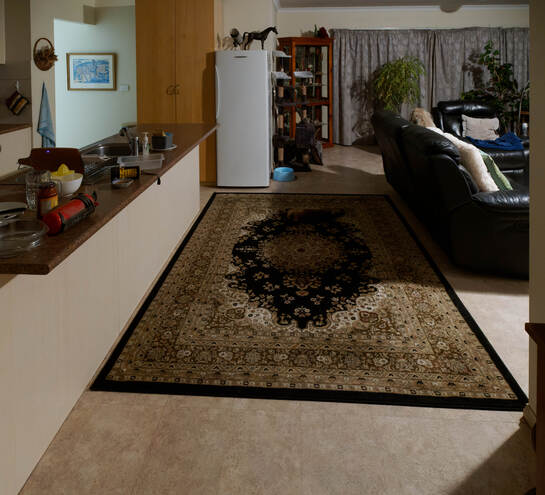
|
|
|||||||||
There's Bruno hiding again. Where? Hard to see, but with some photo processing he's there:

|
|
|||||||||
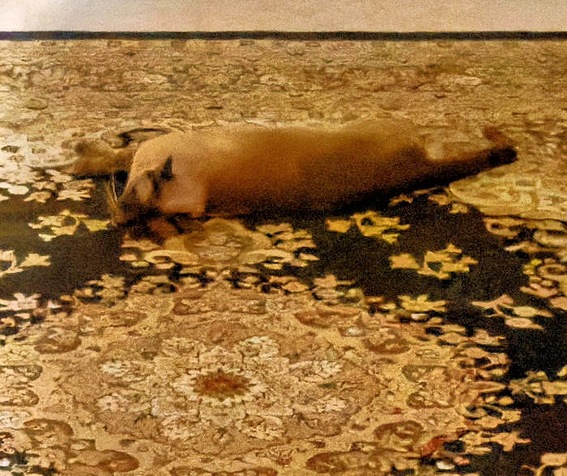
|
|
|||||||||
Hopefully he won't get hurt.
One of the more improbable German TV series is Bettys Diagnose, about the nurses in a clinic in Aachen.
This evening we watched episode 11/2, „Außer Kontrolle“. A person arrived with methanol poisoning. How could they tell? She was very drunk and saw double. Only those are not the symptoms: yes, methanol is very dangerous for the eyesight, but Google Gemini tells me the symptoms are blurred vision, Photophobia (sensitivity to light), "snowstorm vision" or "halo vision", decreased visual acuity, complete or partial blindness (often permanent), dilated pupils, optic disc hyperemia (redness of the optic nerve head) and retinal oedema. Seeing double is something completely different. And she had only drunk one glass of contaminated spirits, which wouldn't have left her seriously drunk the following day.
But then the script writer found something useful:
Methanol wird von der Leber anders verwertet als gewöhnlicher Alkohol: Es entsteht Ameisensäure und Formaldehyd.
“Methanol is metabolized to formic acid and formaldehyde”. Well, yes, though in the opposite sequence. But then the script writer seems to have lost interest in his sources:
Wir beschäftigen jetzt Ihre Leber mit Alkohol, damit diese das Methanol nicht umwandelt in Ethanol.
“We will occupy your liver with alcohol, so that it (the liver) doesn't change the methanol into ethanol”. Clearly he doesn't have the foggiest idea what ethanol is. One can only hope that people watching the programme don't believe the nonsense presented there.
| Wednesday, 9 July 2025 | Today's diary | Today's images | top | previous | next | last |
So where did I put the information needed to update my local systems? I had some recollection that I had a set of Makefiles to do the work. Off searching, and after only half an hour I found them: in /src/Sysconfig/Install.
/src/Sysconfig is a remnant of an attempt I made decades ago to automate my updates, so it's not completely inappropriate, but I was trying to get rid of the system. Still, I can't see any alternative. Off to try out the things that I had in there, in the process finding additional symlinks that I needed to make, and also some missing in the list. And more ports to install. s3cmd was a surprise. pkg spells it py311-s3cmd:
py311-s3cmd-2.4.0_3 Unix-like tools to manipulate stored files from the command line
And after installation, I couldn't start it. Further investigation showed that it didn't install anything like an executable:
=== root@lagune (/dev/pts/2) /home/grog/Install 24 -> find /usr/local/ -mmin -60 | grep s3c
/usr/local/lib/python3.11/site-packages/s3cmd-2.4.0-py3.11.egg-info
/usr/local/share/licenses/py311-s3cmd-2.4.0_3
/usr/local/share/doc/s3cmd
It installed fine from the port (which calls it net/pys3cmd). What am I missing?
I've been dragging my heels on getting the sensor problem with my OM System OM-1 Mark II repaired, but it has to be done. How do I go about it? CCCWarehouse has a contact page that seems a
good start. “Send A Help Desk Ticket” (clearly their capitalization), with the promise “We
will reply promptly by email (typically 0.5-1hr during business hours)”. Sent the message
off at 13:54 and heard nothing for the rest of the afternoon. But at 02:26:24
-0700 19:26 I got a response: please send images.
OK, I can do that. I'm still worried that this could be an uphill battle, though arguably OM System support might have reacted similarly.
| Thursday, 10 July 2025 | Today's diary | Today's images | top | previous | next | last |
Yvonne up this morning to report chest pain consistent with cardiac issues. Her KardiaMobile 6L reported no problems.
Mail to Professor Peter Kistler and Dr Rodney Reddy, but Reddy is on holiday for the next two weeks and recommends contacting Paul Smith, who is also not available until early August. About the best information so far is that it seems to be not overly dangerous.
After buying the Chinese Japanese ramen noodles last week, it was clear that I needed to use them.
I really don't have a good feeling for Japanese food. Everything I try seems to be influenced by Chinese food. Looking for recipes didn't help. My cookbooks don't even mention ramen, and online recipes are all a bit strange. I've established that there are three different types of ramen soup, shoyu (soya sauce based), miso and shiyo (salt). I had a lot of miso left over, so that's what I chose.
But what broth? Some kind of dashi, of course. Ah! I have some instant dashi, which I have never used:

|
|
|||||||||
It comes in sachets weighing 10 g each, with instructions about how to use 4 g to make 600 ml of broth:

|
|
|||||||||
Sometimes I wonder what people are thinking. Wouldn't it be easier to say that the sachet makes 1.5 l, or that 1 g makes 150 ml? In passing, it's worth noting the 200 ml cups.
And the other ingredients? Fish cake, fried pork or chicken and ramen eggs (make the day before). They all have one thing in common: I don't have them. So I cheated based on my experience with Chinese soups. My recipe for next time is here.
Message to CCCWarehouse today with a number of images showing the problem on the OM System OM-1 Mark II. No response today, which somehow didn't surprise me.
While walking the dogs today, saw this bird at the entrance to the house:

|
|
|||||||||

|
|
|||||||||
What is it? Yvonne thought that it was a Kleiber (nuthatch), particularly because of the way it climbed up the tree. It also made a continuous beeping noise. But it doesn't look much like the nuthatches in the photos I found online. Once again Google Gemini to the rescue, maybe. It could be a Daphoenositta chrysoptera, which even Wikipedia calls a varied sitella, but none of the images show the orange spot on the cheek, and the plumage looks different.
And then I discovered that I had taken the photos at 100,000/51° ISO! I had set that for demonstrating the sensor problems on the camera, and then forgot to reset it. Under the circumstances, I'm surprised how good the image looks.
I'm still trying to get used to our new dishwasher. It's glacially slow, taking up to an hour longer than the Bosch machine, which was already slower than the Whirlpool. But I'm still having difficulty getting all my things into the machine, especially the top shelf. Part of the issue is the way the top shelf is divided. Somehow the designers expect a very different load from what I have, and the divisions don't work for me.
This isn't a specific issue with LG. The top shelf is laid out almost identically to the Bosch. But the Whirlpool seemed to do it better. Is this just what I'm used to, or a difference between me and the world? I'm taking a series of photos to follow my progress. Today I wasn't able to get everything in, whereas I'm sure I would have done with the Whirlpool. Here I can either get the Chinese bowl or the beer glass at front right:

|
|
|||||||||

|
|
|||||||||
It's not full, but there are spaces where I can't put anything useful.
ALDI had fresh pizza dough on offer last week, so Yvonne bought some, and we tried it out. It's very difficult to roll out. This is the best that she managed:

|
|
|||||||||

|
|
|||||||||

|
|
|||||||||
OK, that will have to do. But there was a problem: the raw dough was on the paper, and we couldn't lift it off! Nothing for it, put it up against another tray, peel off the paper, turn back again. To my surprise, most of the topping stayed where it should have been:

|
|
|||||||||
But I still couldn't get the pizza off the tray! In the end put the tray into the oven on top of the pizza stone:

|
|
|||||||||
And I still couldn't get the pizza off the tray. In the end I had to destroy it:

|
|
|||||||||

|
|
|||||||||
It wasn't until much later that we realized what had gone wrong: normally I pre-cook the base before topping it. Probably because of the different procedure we forgot this time. Still, there's nothing about the dough that suggests that we should repeat the experiment. Our own dough is just as good and costs much less dough.
The good news is that the oven worked normally. I don't know what went wrong last week, but it heated up normally, and the stone reached 272° before cooking. A pity that it didn't help much, since the pizza wasn't on it.
Eighteen years ago today we moved into the house in Kleins Road. That's nearly a quarter of my lifetime!
| Friday, 11 July 2025 | Today's diary | Today's images | top | previous | next | last |
I eat deep-fried marinated chicken wings with nasi lemak. How do I marinate them? After some consideration I had come to the conclusion that they need to be cooked in the marinade, which I then freeze as broth for other dishes.
At one point I cooked them sous-vide, but decided against it because it's so messy. But two things speak for sous vide: firstly, cooking them in the pot produces more broth that I can use, and secondly the meat doesn't quite fall off the bone. Is it better sous vide? Yesterday I tried it sous vide again, this time cooking 1 kg (8 wings) for 20 hours at 82° setting (which displayed as 79° or 80°). The result?

|
|
|||||||||
They were rather softer than I expected, but the real surprise was the amount of broth produced, round 800 ml. That's nearly the weight of the wings!

|
|
|||||||||
I had a second batch, so for comparison's sake I cooked them for only 8 hours. Mañana.
In passing, it's interesting to note how much heavier the wings have become. Once 2 kg were 22 wings. Now they're only 15, a 50% increase in weight.
Still no response from CCCWarehouse. Try a “chat” again? Yes, almost immediate response from Michael L, who appears to be the only person in the department, unless it's a generic name for anybody there. He was also the name who gave me the information I got on 22 November 2024.
It quickly became clear that he hadn't read the message I sent. Once again the suggestion that I try pixel remapping. And then he stated that he couldn't find the order number, which I had not sent him. So clearly he hadn't followed up at all.
In the evening, he did:
Based on the existing information, we can not accept your claim because our warranty policy does not transfer to new owner when the product is re-sold.
But the other general expectations are dead pixels are possible and can be dealt with via post processing, and re-mapping
Somehow he can't get past the pixel remapping issue, maybe because he hadn't read carefully. And yes, I knew that CCCWarehouse claimed that the warranty wasn't transferable. That's why I contacted them 2 days later and got the confirmation that the warranty was valid. But that's going to be difficult to prove, even with the transcript that I have. I need to consider all options here; maybe one would be to send the camera to an OM system service centre overseas that respects the warranty that I have (and which makes no mention of transfer of ownership).
I'm getting more and more CAPTCHAs. Why? Are they trying to make me walk crossly? Or are they targeting specific browsers?
| Saturday, 12 July 2025 | Today's diary | Today's images | top | previous | next | last |
Yesterday's chicken wings seemed a little overcooked, so I cooked the second batch for “only” 8 hours instead of 20. Surprise: there was much less juice, only about 300 g instead of 800 g. And they were marginally less inclined to disintegrate. So today I ate a nasi lemak with one wing from each batch.
But despite the long cooking, they still didn't fall off the bone. What else can I do?
I've known Schlumbergera (sometimes called Christmas cactus or Easter cactus) for decades, and they always had the same coloured flowers:

|
|
|||||||||
But two years ago Yana brought some cuttings with her, which have gradually started flowering. The first was the white-flowering one two months ago:

|
|
|||||||||
It's flowering again already:

|
|
|||||||||
And there's a new one with salmon-pink flowers:

|
|
|||||||||
There are two further ones that haven't flowered yet. One isn't looking happy, and may not survive.
I've investigated this irritating increase in CAPTCHAs. It happens on FreeBSD with either firefox or chromium, but not on distress (Microsoft) with firefox. Are they maybe tracking browsers that haven't been updated recently?
| Sunday, 13 July 2025 | Today's diary | top | previous | next | last |
Another day spent catching up (reducing my mail inbox size), with only moderate success. I still have messages months old (over 2 years in one case) that I really need to answer.
Instead I made an equally half-hearted attempt to complete the installation of the new lagoon.lemis.com for Yvonne. The next step was X, particularly the Nvidia driver. lagoon has an ancient GeForce GT 710 card, but it does the job for Yvonne. How do I set up a second machine with the same card? Simple, as it turns out: I have a second one, though it has a sticker on the fan housing saying “noisy”.
And so it was. The fan is clearly sticking, and it took a couple of attempts after power-up for it to run at all. And the nvidia-driver-440 no longer exists, so I tried nvidia-driver-470. And to my surprise it Just Worked.
Next step? Procrastinate. But I need to set the machine so that it comes up automatically (/erc/gettytab and /etc/ttys. And in passing, since lagune (the new machine) was hibernated, I needed to wake it. That's simple enough, maybe: it's already in /etc/ethers as disdain. Well, at least on hydra. That's another file that needs to be NFS mounted across the network. And once again I get the message “/usr/local/libexec/Xorg.wrap: Only console users are allowed to run the X server”, which I need to fix in /usr/local/etc/X11/Xwrapper.config.
We've been watching “A Town like Alice” on TV. Where's the book? We don't seem to have one. Yvonne wanted to buy a copy, but what are libraries for? The Central Highland Libraries must have a copy.
Yes. Well, they can get one from the library network. But inappropriately for a library, they lose information. Both Yvonne's and my login details are no longer valid, and attempts to reset a password don't produce the promised email.
We've seen this before. They let cards expire and don't even bother to inform you of the fact. And somehow their web site is as broken as ever. Mañana.
Interesting question in the German Quora: “Is it true that the words for “whale” and “cat” are the same in Ukrainian?”
Simple answer: no. “Whale” is “кит”, cat is “кішка”. But that reflects the sex of the cat: in German, it's „Katze“, feminine. A male cat is кіт. So we're looking at the pronunciation of the letters и and і. And that seems more complicated than I thought. In the process, came up with the following sites that may help with pronunciation:
What a choice. Well, no. easypronunciation wants a subscription and doesn't do Ukrainian anyway, uni-halle has a very limited range of offerings, and babla doesn't play nicely with ad blockers, so I didn't try.
Result from https://hellpanderrr.github.io/wiktionary_pron/?lang=Ukrainian:
| Word | translation | pronunciation | ||
| кит | whale | [ket] | ||
| кіт | (tom)cat | [kʲit] | ||
| кішка | female cat | [kʲiʃkɐ] |
In principle that's fine. But Stefan Speck, who has a particularly good understanding of languages, comes up with the possible pronunciation [кɨт] for кит.
Why is this all so difficult? Even 60 years ago I had difficulty getting my mouth round [ɨ] (ы).
| Monday, 14 July 2025 | Today's diary | top | previous |
Interesting article in the news today: Ian Williams, a man in Bendigo, was defrauded of $1,338 a few years back. Two items were paid for via Google Pay on his mobile phone. The bank (National Australia Bank) refused to refund the money: he had identified himself with a fingerprint, so he must have been there.
Williams wasn't happy with that, and he sued NAB. The case is ongoing, but his evidence is convincing. He's asking for $379 million in payout, using rather implausible reasoning, and I'm sure he's not expecting to get more than a fraction of that.
But somehow he's barking up the wrong tree. Yes, banks should take more responsibility for abuse. In cases like my Centrelink exploit nobody seemed to care that my money had been transferred to another bank account due to their negligence. With appropriate legislation the bank could have reverted the transfer. In the current case, where food was bought with fraudulent use of the mobile phone, things are different: the shop (Coles) was only marginally involved. The real culprit is Google Pay. Their security checks are inadequate.
How could they improve them? I don't know. That's why I don't put any sensitive information on my mobile phone. But it's time that the government got its act together and found a better security system, like a single reliable (hah!) method of identification, rather than relying on driver licences or dates of birth.
Finally I have got round to posting a message about my issues with the OM System OM-1 Mark II on the exiftool forum. Response from Phil Harvey, the author: “It seems that you mean "Any plans for better OM Workspace support?"”.
Well, no. But at least he'll look at the issue. Am I the only person to run into this problem?
Do you have a comment about something I have written? This is a diary, not a “blog”, and there is deliberately no provision for directly adding comments. It's also not a vehicle for third-party content. But I welcome feedback and try to reply to all messages I receive. See the diary overview for more details. If you do send me a message relating to something I have written, please indicate whether you'd prefer me not to mention your name. Otherwise I'll assume that it's OK to do so.
| Top of page | Greg's home page | Today's diary entry | Greg's photos | Copyright information |